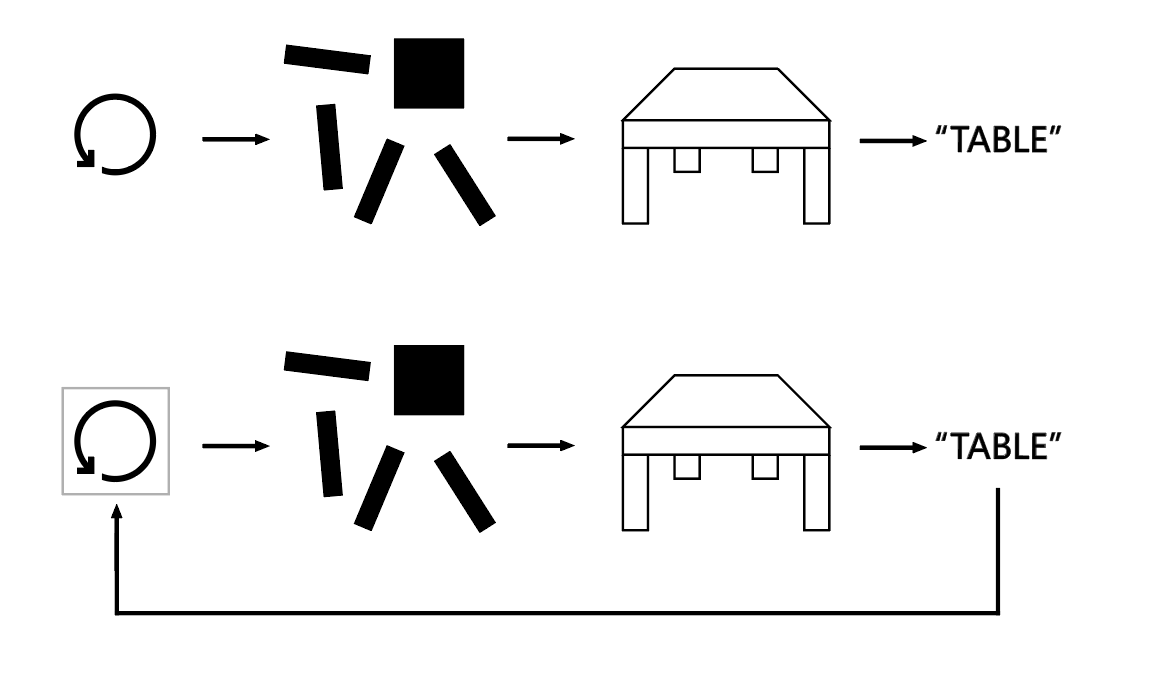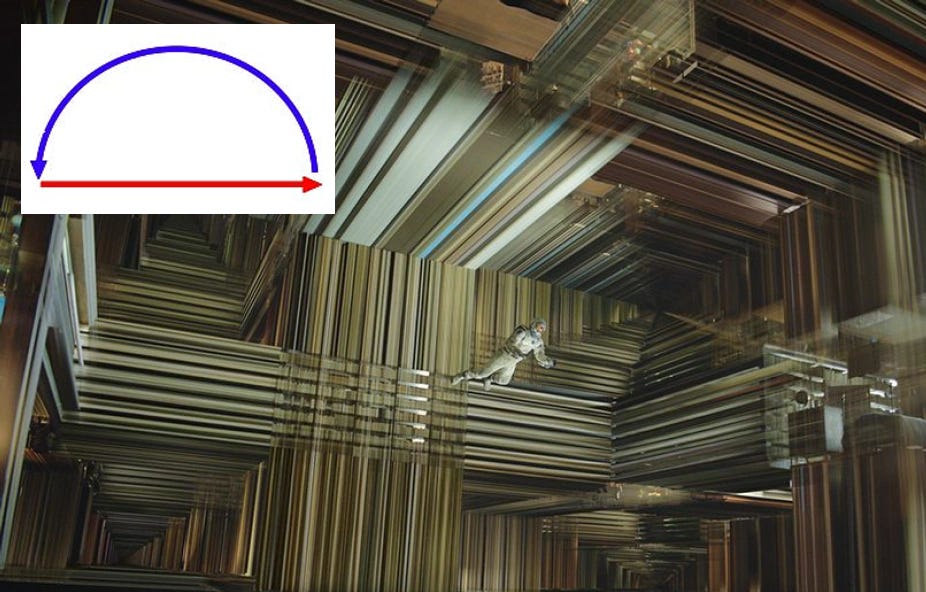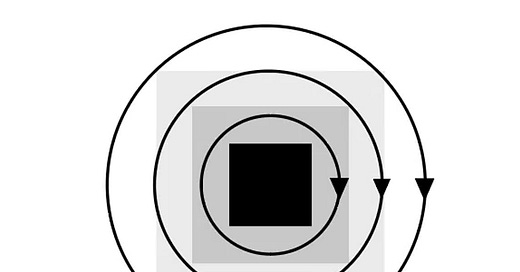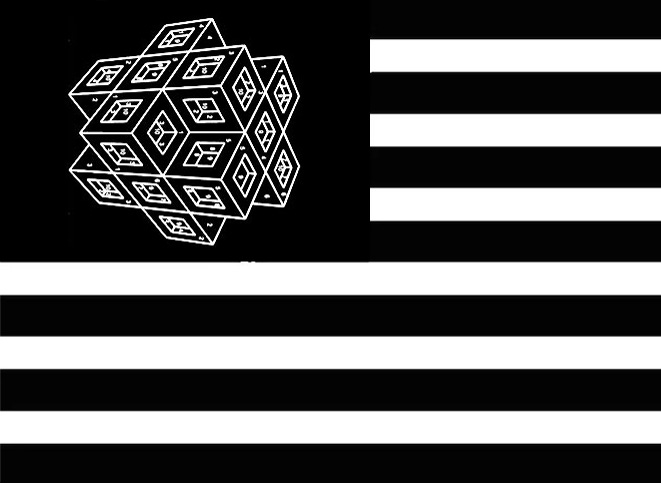One of the most important symbolic developments of our time is hidden in plain sight: the transfer from the cyclic understanding of time to the primarily territorial understanding of time.
“Time as a circle” is the understanding that something can become its own opposite, or however far it goes away from its origins, it will always return to it in the end. “Something goes full circle” —or— “All arguments are circular arguments”. The lunar understanding of time.
“Time as square” is the understanding of telic time, the temporality that the icon and, by extension, the image portray. Here, we exit out of the circularity and see it from “above” as what it is: wholeness. The solar understanding of time —”square sun,” so to speak.
Let’s imagine an image which (like all things) consists of various parts, in this example: A, B, C, and D.
All of these parts are presented as necessary parts to a whole, that of the image, while not one part is equal to the image (A =/= image; B =/= image; etc., etc.,). They make up the identity of the image, but also reflect that identity in their individual sense.
An alternative example: the leg of a table is a separate part that one recognizes. It is also a necessary part that reveals the identity of the table (again, table leg =/= table). But the leg of a table can only exist within the boundaries of the identity of the table, whether it’s (the table’s) revealed or not.

This “boundary of identity” is the “time as square,” which is a “telic territory”.
Each part, whether it’s a part of a table or part of an image (like A, B, C, D), necessarily arises within this “boundary of identity,” becoming part of the identity but not equaling it, instead, each part reflects the identity in its own particular way.
If we look at an image, while it happens really quickly, we don’t see the whole of the image at first; instead, our attention wanders from part to part, creating a “sequence of parts” (red line), eventually returning to its origins, making a full circle. This full circle, which represents coherence and wholeness, is the testament of the identity.
In images, we cannot misunderstand this: the various parts exist simultaneously next to each other, they cohere together to reveal an identity which also justifies their existence.
The red line from our point of view is linear experience; the image in which it happens is the telic territory that is reflected in it.
The way we can misunderstand this is if these parts, like ABCD, are separated over moments in time. Here, “foundationalisms” can arise, which sees a specific sequential nature of parts as fundamental, and so puts the cause above the effect or the effect above the cause. Of course, there’s no methodology for deciding whether the cause or the effect is superior, which is proof that neither is: causality is reversible to retrocausality and vice versa.
In summary, all sequences (red arrow) end at the moment where their interpretation becomes reversible (blue arrow). “End” in all its meanings.
Or in other words, where the causes can become effects or the effects can become causes (and there’s no means by which we can make sure one or the other is true), in that moment we get a circle which reveals the telic territory.
That point of reversibility is also the point where the medium becomes the message, where the parts (message) reveal the telic territory (medium).
This temporality is what Icons, and in a broader sense, the medium of the image, tries to convey: the cross references in the bible (as you can see above) are presented in the icon as an immediacy, as a presence not separated by the duration and sequencing of the tex, (which reflects its separation in time).
This also means that the text reflects a series of embedded images that were always present.
Again, this is not only true with the bible, but all possible sequences.
On the left: the telic territory before revelation. Think of your attention moving across an image or reading the text of the bible. For now, you only see sequences.
You are “exterior” to the telic territory.
On the right: the telic territory after revelation. After your attention moved across the image, you now recognize it. Or, when it comes to the bible, you see the cross references. After the revelation, the sequences become a structure of initiation.
You are now “interior” to the telic territory.
The telic territory is stationary, immediate, and present. Our relation to it is that of exteriority and interiority. “Conscious experience” only sees such sequences; it has to be initiated into the telic territories to see noetically.
From the exterior: Noah’s Ark; from the interior: Liturgical Calendar
From the exterior of Noah’s Ark, the flood is absolute disintegration, while from the interior of the Ark (of the Covenant), it’s the renewing waters that prepare the arrival of the New World. Both frames are equally right.
Similarly to the reversibility of cause and effect, interior and exterior make interpretation—framing, reversible. The frame is a symbol of “time as square” —as post-modern philosophy aptly noticed, narrative framing —telic territory— was more fundamental than anything else.
The possibility of framing and reframing, of course, is the immediate presence of an eschatological reality: the ultimate frame is that which can reframe everything.
A metaposition that has a position and vice versa.
Thus the ultimately, revelation and initiation are reversible properties of the same meta-temporal structure. The depiction of this structure above, however, is too flat. A much more apt depiction would be a tesseract, as the movement of circularity is synchronous with the interiority and exteriority of this meta-structure.

So, here we return to the image and the question of what the “symbolism of time as square” is? But before that, here’s a summary:
STAGE 1: The image points out how a sequence is reversible (red arrow to blue arrow) in reality.
STAGE 2: Because the image can do that, and bring these collapses of causality and retrocausality to the present, it can also depict itself doing that. Now we have the presence of something that depicts how telic territories work.
STAGE 3: At that point, the image as now “a territory” becomes omnipresent as both the end and the beginning of the world. Becoming the telic territory that initiates and reveals all telic territories.
Of course, ultimately, this Image is the Image of God, Christ. (John 1:1-14)
However, there’s also another important detail when it comes to depicting time as a square: the image of the square, and more broadly, the image of the tesseract, is the image of images, or in other words, the image of symbolism itself. Especially if we try to gauge the symbolism of technology…
telic territory = time as square = image = symbol
Instead of depicting the image as a totality of the parts “ABCD”, which are clear parts, I’d like to depict it more from the point of view of the observer, depicting the gestalt of its parts more as a “riddle”.
The red line in the case of the image was and is attention. A puzzling image is akin to a visual maze, where there are many dead ends and turns one has to make until the purpose of the image —the telic territory— is revealed.
Of course, this red line can be translated to any linearity: language, movement, thought, even causality itself, in relation to the telic territory; in relation to the symbol. We can also see more and more of those things having their context ripped from their traditional places (the most obvious is attention itself) and recapitulated within cybernetic, computer architecture.
Computer architecture that has a cubic, square structure.
City, motherboard, processor, liturgical calendar —all matrices.
A matrix, of course, is the territory of a grid —symbolically, the matrix is the understanding of territory as telic.
In the movie The Matrix, the simulated reality was completely teleological: it was all built as a power plant for the machines, and so all telic territories that humans observed within the simulation had their ultimate end in the outside of said simulated reality.
In Inception, each world is embedded in one another, all with a central purpose, as ultimately they all reflect the meaning found within the vault.
The New Jerusalem and the Church are both feminine in that regard, hence the relation of matrix and mother.
Similarly to how the ultimate telic territory is a point of access to all telic territories, the icons on a smartphone access various “mediums” to navigate.
As an article this is already long enough and cramped enough with information, I’ll end this one here, however, there’s another in the works that should somewhat expand and reflect on some of the things presented here from a totally different point of view.
More articles around this topic:
The Mainframe Behind Your Dreams
Throughout human history, mediation with the vertical (traditionally the sacred) has occurred through “artificial structuring.”























I would be slightly disappointed if the next article wasn't about trigonometry.
Yes. “Where” did something happen instead of “when”.